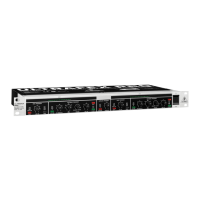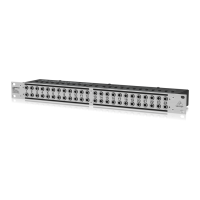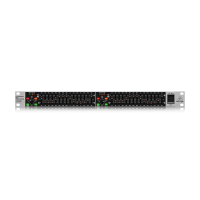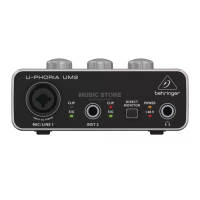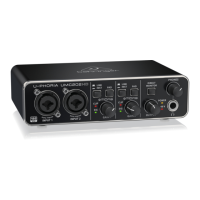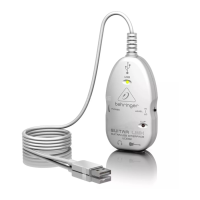(EN) Step 1: Controls
(1) The DCX2496(LE) features 6-segment LED
displays (plus CLIP and MUTELED) for precise
level adjustment of input signals A-B or A-C.
(2) If the input stage is overdriven, the CLIP LED will
indicate that the signal isdistorting.
(3) The bottom LED (#8) is the MUTE LED (red),
which illuminates when the respective input
is muted.
(4) These are the input channel buttons, which allow
you to activate speci c functions from the selected
menus (e.g. MUTE). Additionally, you can use these
buttons to call up the IN A/B/C menus.
(5) The DISPLAY shows all the menus available for
preset editing.
(6) Use these buttons to call up the DCX2496(LE)’s
menus (e.g. SETUP, RECALL, etc.). The only
exception is the COMPARE button, which allows
you to compare the edits made with the
previously selected presets. When COMPARE is
active, no value changes can be entered.
(7) The PAGE buttons select single pages from
onemenu.
(8) Individual parameters can be selected with the
PARAM buttons.
(9) The data wheel allows you to edit the
selectedparameters.
(10) With the OK and CANCEL buttons you can either
con rm or cancel any settings made.
(11) Outputs 1-6 each have a 5-segment LED display
(plus MUTE, CLIP and LIMIT LED) showing the
respective output levels.
(12) Like the input stages, the output stages should
not be overdriven, i.e. the CLIP LED should
notilluminate.
(13) The LIMIT LED illuminates when the limiter for
the corres ponding output has been activated and
is operating.
(14) The bottom LED indicator (#8) is the MUTE LED,
which illuminates as soon as the corresponding
output is muted.
(15) Output channel buttons, with which you can
enter the outputs 1-6 or mute or reactivate
individual outputs in MUTE mode.
(16) Use the POWER switch to put your DCX2496(LE)
into operation. The POWER switch should always
be in the “O ” position when you are about to
connect your unit to the mains.
(17) This is the FUSE HOLDER of your DCX2496(LE).
Blown fuses must be replaced by a fuse of the
same type and rating.
(18) The mains connection is an IEC receptacle.
Anappropriate power cord isincluded.
(19) The 9-pin RS-232 interface allows you to connect
your DCX2496 to a computer. This enables you to
save and load les, update the DCX2496 operating
software, or remotely control one or several
ULTRADRIVE PRO units from a PC. Free editor
software can be downloaded at behringer.com.
(20) When you have daisy-chained several
ULTRADRIVEPRO via the LINK connectors (see
(21)),
please press the TERM switch on the rst and last
unit of the chain, to avoid data re ections and
transmission errors.
(21) Use the LINK connectors A and B (RS-485 network
interface) anda commercially available network
cable to daisy-chain several ULTRADRIVEPROs.
(22) Balanced XLR output connectors for output
channels 1-6. Connect your power amps here.
(23) Balanced XLR input connectors A-B / A-C are used
for connecting input signals.
DCX2496:
Input A can also be used for digital AES/EBU input
signals. Input C can be used for line signals or for
connecting a measuring microphone. If AUTO
ALIGN has been enabled in the SETUP menu,
input C will be set for mic levels automatically.
Additionally, phantom power for the measuring
microphone will be switched on.
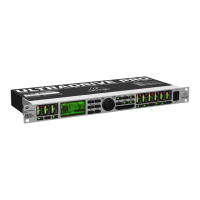
